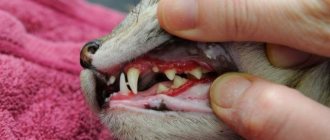How does calcivirus infection occur?
In order to protect an animal from infection with calcivirus, it is necessary to understand how infection with the virus occurs.
The source of the disease is an infected individual. Any contact with a sick animal can lead to disease.
The danger is posed not only by the carrier of the disease, but also by all the products of his vital activity. From discharge from the eyes and nose to all other excrement.
It is important for breeders to know that the virus is transmitted not only from an individual with severe symptoms, but also in a latent form.
The disease is mainly transmitted in the following ways:
- direct contact with an infected animal;
- airborne;
- through a person;
- through contaminated food and water;
- Through waste products of an infected individual.
The most dangerous, of course, is contact with a sick animal. During mating, even despite vaccination, partners can “pick up” the virus from each other.
An infected cat can pass the disease to her kittens.
A person carries the infection on clothes, shoes, skin and hair. In this case, the virus remains viable for up to five days.
The risk of infection increases if the breeder allows the pet to walk outside with other cats. The radius of the virus is at least a meter, so the disease is often transmitted by airborne droplets.
Vaccination against calcivirus after illness
To prevent the development of an infectious disease - calcivirosis, the pet is vaccinated annually with special preparations, after consulting with a veterinarian. Kittens are allowed to get vaccinated at 9 - 12 weeks of life. Vaccinations are very effective in protecting animals from serious consequences. If the cat was not promptly vaccinated against calcivirus infection, then there is a high probability that she may give birth to dead kittens due to illness during pregnancy.
Revaccination is carried out once a year; vaccination allows you to protect your pet from a serious viral disease by building its immunity. Calcivirus in a vaccinated cat occurs with more severe symptoms and in a mild form, without causing serious harm to the pet’s health.
Symptoms of calcivirosis in cats
The main insidiousness of calcivirosis is that it is easily confused with other bacterial ailments.
General weakness. Watery eyes and runny nose. Decreased appetite. Increased body temperature. Sneezing. It’s hard to argue that this is how the vast majority of diseases begin.
As a rule, not all breeders pay due attention to changes in the pet’s well-being. This is especially dangerous because neglect of the disease leads to its exacerbation. Up to and including death.
In general, feline calcivirosis is often compared to human influenza. Diseases begin in approximately the same way. In both cases, an unfavorable end is possible due to complications due to neglect.
The first symptoms appear within one to two days. Next, the animal’s nasal congestion increases, and the cat begins to breathe through its mouth. Discharge from the eyes and nose is thick mucus or exudate with pus.
However, even at this stage, not everyone notices calcivirus. Only on the fifth day do specific signs of the disease begin to appear. The gums become inflamed and stomatitis is diagnosed. Ulcers appear in the mouth. They may also appear in the nose.
Still no appetite. The cat practically doesn't drink. The pet coughs all the time, as if he was choking. The oral cavity is swollen, red, there may be a whitish coating and an unpleasant odor. In addition, the animal suffers from excessive salivation.
On average, after three to four days the manifestation of symptoms ends. During treatment, of course.
Sometimes atypical manifestations of the virus occur:
- inflammation of the joints, accompanied by lameness and pain;
- ulcers on the skin;
- the intestines and stomach are affected by ulcers (extremely rare).
The illness lasts from seven to ten days. In severe form, the duration increases to twenty-one days.
However, the pet's recovery does not mean the virus disappears. For several more months, the animal will pose a danger to other four-legged fellows and to future offspring.
There are cases where cats remained carriers of the virus throughout their lives.
At-risk groups
The Murkoshi team would like to draw your attention to the fact that calcivirus is not dangerous for humans and other animal species; only representatives of the cat family are affected by it.
The most susceptible to calcivirus is a kitten under one year old. Children have the highest mortality rate; they tolerate the disease very hard - with all the symptoms. Adult cats also get sick, and the virus is especially dangerous for those individuals who have problems with the immune system or who have chronic diseases.
Treatment of calcivirosis
Effective treatment of calcivirosis begins with a correct diagnosis. Due to the difficulty of diagnosing the disease, it is recommended to contact a veterinary clinic at the first signs of your pet’s discomfort.
A caring breeder knows that the sooner you provide correct assistance to your pet, the lower the risk of complications.
As a rule, therapy begins with the use of broad-spectrum antibiotics. The next step is taken towards raising immunity. For this purpose, stimulants and vitamins are used.
Lack of appetite and high temperature lead to exhaustion and dehydration. Therefore, to ensure the vital functions of the body of a sick animal, a nutrient solution is administered.
Calcivirosis is accompanied by thick discharge from the eyes and nose. Cleansing is done with saline solution.
Therapeutic and preventive measures of the oral cavity are used. With proper treatment, noticeable improvements occur already on the second or third day. The main thing is not to delude yourself! The virus has not yet been defeated. It is required to continue the procedures for the period indicated by the veterinarian. Typically, active therapy lasts from five to seven days.
Interruption of treatment risks relapse and severe complications.
Diagnostics
Diagnostic measures begin with an initial appointment, at which the doctor examines the clinical picture and anamnesis, assesses the general condition of the animal. The owner must tell the veterinarian in as much detail as possible about all the events and contacts of the pet that preceded the disease.
The clinic conducts the following studies:
- general urine analysis;
- general and clinical blood test;
- PCR analysis, testing to identify antibodies in blood serum to FCV.
To obtain reliable information, PCR analysis must be repeated after a few days. In some cases, the doctor prescribes a chest X-ray.
All these tests are necessary to accurately identify the viral nature of the disease and exclude other pathologies with a similar clinical picture: rhinotracheitis, chlamydia, etc.
Complications
In the case of calcivirosis, it is important to understand that the disease itself is not nearly as dangerous as the possible complications. They arise due to improper treatment, its absence or late diagnosis.
The most common complications of calcivirosis in cats are:
- pneumonia;
- dehydration;
- gum inflammation can lead to tooth loss;
- the chronic form of calcivirosis leads to renal failure.
Less common are cases where, after an illness, an animal suffers from increased excitability of the nervous system, secondary bronchitis, brain damage, and a weakened immune system.
Treatment at home
For non-severe forms of the disease, the cat can be treated at home. The cat needs to be isolated from other animals. Use medications every day strictly as prescribed by the doctor, also clean your nose and eyes with antibiotics, sanitize the oral cavity, rinse ulcers with medications and or chamomile decoction.
Be sure to administer Ringer's solution, sodium chloride, or glucose if there are signs of dehydration.
You need to monitor your pet’s diet, as this gentle food, rich in vitamins, guarantees your pet’s quick recovery.
Complications after calcivirosis
Frequent complications (in 30% of patients with feline calcivirus) are:
- Secondary bronchitis;
- Bronchopneumonia;
- Atelectasis;
- Increased nervous excitability;
- Twitching of limbs, convulsions;
- Weakening of the immune system;
- Brain damage.
Timely treatment will reduce the likelihood of serious complications that threaten the life of your beloved furry.
Caring for a pet during illness
In order for the pet to recover as quickly as possible, it requires care and attention from the owner.
Be sure to change the animal's bedding on a daily basis. The used lounger is washed and steamed. Your pet needs peace and tranquility. Moderate attention.
If your four-legged friend completely refuses water, he is forcibly given water using a syringe without a needle.
To increase appetite, they resort to canned food or preserves. The food is slightly warmed beforehand to enhance the flavor.
The room in which the patient lives is regularly ventilated. Do wet cleaning with disinfectants.
See also: Panleukopenia in cats and its symptoms
What does the virus infect?
Weak cats with poor immunity are susceptible to calcivirus. The weaker the body, the more serious the consequences and the more organs the disease affects. This is why this disease is so dangerous for kittens.
Viral calcivirus can affect the following systems:
- Respiratory. In addition to ulcers on the nose and mouth (as can be seen in the photo), rhinitis and pneumonia are possible. Manifested by difficulty breathing, shortness of breath.
- Gastrointestinal. Ulcers can also be on the intestines.
- Muscular. Manifested by lameness, inflammation of the joints.
- Damage to the mucous system of the eyes - conjunctivitis, the presence of discharge.
Chronic calcivirosis also occurs. It may not appear as clearly as the acute subtype.
Prevention of calcivirosis in cats
It is known that there is no 100% protection for a cat from infection with calicivirus. But this does not mean that you need to sit and hope for a miracle.
There are certain measures that breeders can take to minimize the risk of contracting the virus and also alleviate possible complications.
The main recommendations are as follows:
- Regular ventilation of the premises (house, apartment);
- Balanced diet;
- Minimizing contact with stray animals;
- Regular cleaning and disinfection of water and food bowls;
- Regular and timely cleaning, as well as disinfection of the cat litter box. The use of rubber gloves is mandatory;
- Vaccination.
Vaccinations are perhaps one of the most important measures against calcivirus. It is vaccination that can minimize the risk of complications. In addition, a vaccinated pet is much easier to tolerate the disease.
It is important to know that you should consult your veterinarian before vaccination. The animal must be absolutely healthy. The vaccine places a significant strain on the immune system. If it is weakened, then the injection will do more harm than good.
Ten days before the event, the pet is dewormed.
Pregnant cats are not vaccinated.
The first vaccinations are given to kittens at eight to twelve weeks of age. The further vaccination schedule is coordinated with a veterinarian, who will take into account the characteristics of the breed and the pet’s lifestyle.
Routes of infection
A cat can catch calcivirus while walking: a sick animal sneezes towards a healthy one (the radius of the lesion is up to one meter), the pet can smell the feces of a sick animal or lie in the grass where the carrier’s excretions remain.
If the virus gets on the owner's skin, clothes or shoes, it also poses a danger to cats who do not leave the apartment. If you were visiting where the cat was already sick, you can still bring the virus into your home from it, because this cat remains a virus carrier for several more months.
After visiting cat shows, observe your pet for a few days. There may be cats with calcivirosis, or they may be its carrier, and in the first days the disease does not manifest itself.
Causes of the disease
Pathology is quite often diagnosed in infants. Before the first year, about 10-11% of infants suffer from it. Doctors list the main reasons for the development of the disease:
- infection with respiratory syncytial virus, rhinovirus, adenovirus;
- entry into the body of respiratory, fungal and other infections.
As soon as any of the listed viruses or infections enters the body, pathological processes begin to develop. The airways become inflamed, the bronchioles narrow, as a result of which air circulation becomes significantly more difficult. Source: Sukhorukova D.N., Kuznetsova T.A. Epidemiology of acute bronchitis and bronchiolitis in children Eurasian Union of Scientists, 2016.
Experts say that the infection more often enters the body of those infants whose mothers smoke or smoked during pregnancy. In these children, the disease is also more severe. At the same time, breastfed children are less likely to be at risk. Often the virus only causes a cold in them, which does not develop into more complex diseases.
Types of bronchiolitis in children
Depending on the duration of symptoms, pathology is divided into two main types:
- Acute – bronchiolitis, which lasts in children for 7-10 days. Coughing and wheezing may persist for up to 2-4 weeks. As a rule, it passes without consequences for the baby’s health Source: Delyagin V.M. Acute bronchiolitis in children Medical Council No. 1 2013, pp. 64-68.
- Chronic - bronchiolitis, which appears in children as a result of complications of the acute form of the disease. Characterized by the persistence of symptoms for 3-4 months a year with periodic remissions and exacerbations.
Mechanism of disease development
Reproduction of bacteria begins in the cytoplasm of cells of the mucous membrane, upper respiratory tract, conjunctiva, which leads to their degeneration and death. In the spaces where the virus is introduced, groups of bubbles with colorless contents are created. When lightly pressed, the membrane of the liquid formations collapses, revealing bleeding ulcers.
The infected contents of the vesicles, falling on other parts of the mucosa, cause the appearance of fresh lesions. The causative agent of calcivirosis can affect lung and kidney tissue.
The incubation stage of calcivirosis (from the microbe entering the body to the onset of illness) ranges from a couple of days to 20 days.











